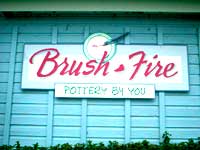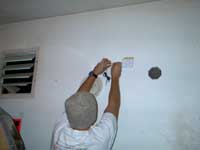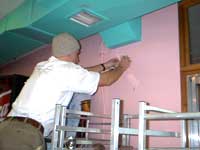
A Vital signs case study of Brush-Fire Pottery
|
|
|
|
|
|
| Conclusions |
Learned |
|
Acknowledgments | Appendix |
We found that a great deal of the the kiln room's heat escapes from an open wall vent (fig. 29). While this is beneficial in the summer, we believe that the radiant heat from the kilns could be put to use in heating the studio space in the winter toxins from the firing process are vented directly to the outside. In addition, we still believe that improvements to the current ventilation system could improve summer ventilation of the excess heat produced by the kilns. Such an improvement could decrease the building's reliance on forced air/heat, conserving energy and decreasing electricity bills.
A simple and inexpensive solution would be to add a fan to the open-air vent already existing in the North wall (fig. 29) and also adding a fan to the interior wall (fig. 30) separating the kiln and studio spaces. In the winter, the vent to the exterior could be closed and the fan into the studio turned on. The warm air from the kiln room would then be pushed into the studio and would reduce the amount of energy needed to heat that space. In the summer, the interior vent would be closed and the fan to the exterior would blow the heat out of the building, cutting the cost of air conditioning.
 |
 |
vent found on the exterior/north wall (left) and vent found in the studio space connected to the kiln space (right)